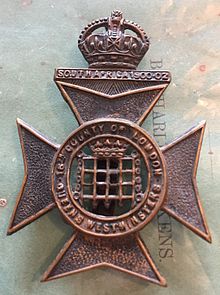Queen's Westminster Rifles
| Queen's Westminsters | |
|---|---|

Cap Badge.
|
|
| Active | 1860–1961 |
| Country |
|
| Branch |
|
| Type | Infantry |
| Role | Infantry |
| Part of | London Regiment |
| Garrison/HQ | 58 Buckingham Gate (1886–1961) |
| Commanders | |
| Honorary Colonels |
Hugh Grosvenor, 1st Duke of Westminster (1881) Field Marshal HM King Edward VII (1921) Sir Edward Geoffrey Hippisley-Cox CBE TD DL (1939) Major Robert Anthony Eden, 1st Earl of Avon and Viscount Eden of Royal Leamington Spa KG MC (1952) |
The Queen's Westminsters were an infantry regiment of the Territorial Army, part of the British Army. Originally formed from Rifle Volunteer Corps, which were established after a French invasion scare of 1859. The unit became part of the newly established London Regiment on the formation of the Territorial Force in 1908. It was subsequently amalgamated in 1921 with the Civil Service Rifles, and became a territorial Battalion of the King's Royal Rifle Corps in 1937. It ceased to exist as separate entity after it was amalgamated in 1961.
The regiment was founded on the formation of the Volunteer Force, raised by the Duke of Westminster and named in honour of Queen Victoria in 1860. In the 1880s the unit became the 13th Middlesex (Queen's Westminster) Volunteer Rifle Corps and were attached to the King's Royal Rifle Corps as a Volunteer Battalion. In 1886 the battalion established its headquarters at 58 Buckingham Gate, Westminster. and by 1902 it was the largest volunteer rifle corps battalion in London.
Under the Haldane Reforms that created the Territorial Force in 1908, the battalion was included in the new all-Territorial London Regiment, taking its place as the 16th (County of London) Battalion, The London Regiment (Queen's Westminsters).
On the outbreak of the First World War the battalion was designated 1/16th (County of London) Battalion (Queen's Westminster Rifles). At this stage it was part of 4th London Brigade, part of the 2nd London Division. On mobilisation it moved to the Hemel Hempstead area. On 3 November 1914 it left the Division and landed at Le Havre. On 12 November 1914 it came under command of 18th Brigade in the 6th Division.
...
Wikipedia
